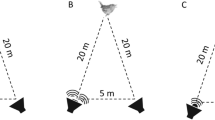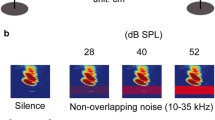Summary
Territorial male red-winged blackbirds use many different “alert” calls which overlap broadly in the context of their use and which are often given in continuous, repetitive fashion. Males give one call type many times before switching to another type, and call during all daily activities. In this field study we demonstrate that males tend to give the same call types as their neighbors and change types to match the changes of their neighbors. Individual males change call types in response to the appearance of a mounted hawk and also match call type changes broadcast from a loudspeaker. The various call types are not associated with particular behavioral contexts. We suggest that red-winged blackbirds operate a general acoustic alert system by calling repetitiously and changing call types when detecting environmental changes such as appearances of predators. Evidence is presented that communication is acheived primarily during switching among different call signals, and not by specific calls that refer to particular stimuli or states of alertness.
Similar content being viewed by others
References
Beer CG (1982) Conceptual issues in the study of communication. In: Kroodsma DE, Miller EH (eds) Acoustic communication in birds. Vol 2, Academic Press, New York, pp 279–310
Busnel R-G (1968) Acoustic communication. In: Sebeok TA (ed) Animal communication. Indiana University Press, Bloomington, IN, pp 127–153
Catchpole CK (1983) Variation in the song of the great reed warbler Acrocephalus arundinaceua in relation to mate attraction and territorial defence. Anim Behav 31:1217–1225
Falls JB (1982) Individual recognition by sounds in birds. In: Kroodsma DE, Miller EH (eds) Acoustic comminication in birds. Vol 2, Academic Press, New York, pp 237–277
Falls JB, Krebs JR, McGregor PK (1982) Song matching in the Great Tit (Parus major); The effect of similarity and familiarity. Anim Behav 30:997–1009
Krebs JR (1977) The significance of song repertoires: The Beau Geste hypothesis. Anim Behav 25:475–478
Krebs JR, Ashcroft R, Van Orsdol K (1981) Song matching in the Great Tit Parus major. Anim Behav 29:918–923
Krebs JR, Dawkins R (1984) Animal signals: Mind-reading and manipulation. In: Krebs JR, Davies NB (eds) Behavioural ecology, 2nd ed. Sinauer, Sunderland, MA, pp 380–402
Krebs JR, Kroodsma DE (1980) Repertoires and geographical variation in bird song. In: Rosenblatt JS, Hinde RA, Beer CG, Busnel M-C (eds) Advances in the study of behavior. Vol 11, Academic Press, New York, pp 143–177
Morton ES, Shalter MD (1977) Vocal response to predators in pair-bonded Carolina Wrens. Condor 79:222–227
Moynihan MH (1970) Control, suppression, decay, disappearnance and replacement of displays. J Theor Biol 29:85–112
Orians GH (1980) Some adaptations of marsh-nesting blackbirds. Princeton University Press, Princeton, NJ
Orians GH, Christman GM (1968) A comparative study of the behavior of red-winged, tricolored, and yellow-headed blackbirds. Univ Calif Publ Zool 84:1–85
Peek FW (1971) Seasonal change in the breeding behavior of the male red-winged blackbird. Wilson Bull 83:383–395
Schleidt WM (1973) Tonic communication: Continual effects of discrete signs in animal communication systems. J Theor Biol 42:359–386
Searcy WA, Searcy MH, Marler P (1982) The response of swamp sparrows to acoustically distinct song types. Behaviour 80:70–83
Smith WJ (1965) Message, meaning, and context in ethology. Am Nat 99:405–409
Smith WJ (1968) Message-meaning analysis. In: Sebeok TA (ed) Animal communication. Indiana University Press, Bloomington, IN, pp 44–60
Smith WJ (1977) The behavior of communicating. Harvard University Press, Cambridge, MA
Whitney CL, Miller J (1983) Song matching in the Wood Thrush (Hylocichla mustelina): A function of song dissimilarity. Anim Behav 31:457–461
Wilson EO (1975) Sociobiology. Harvard University Press, Cambridge, MA
Author information
Authors and Affiliations
Rights and permissions
About this article
Cite this article
Beletsky, L.D., Higgins, B.J. & Orians, G.H. Communication by changing signals: call switching in red-winged blackbirds. Behav Ecol Sociobiol 18, 221–229 (1986). https://doi.org/10.1007/BF00290826
Received:
Accepted:
Issue Date:
DOI: https://doi.org/10.1007/BF00290826




